You may have heard of halo-halo and ube, but how many more Filipino desserts can you name? Those are two of the most popular desserts in Filipino cuisine but there are so many more tasty sweet treats you need to try on your next visit to the Philippines.
If you have a sweet tooth and are planning that next big trip to the Philippines, then here are 25 delicious Filipino desserts that you absolutely cannot miss.
Save This on Pinterest!
No time to read this article on Filipino desserts? Click on the save button and pin it for later!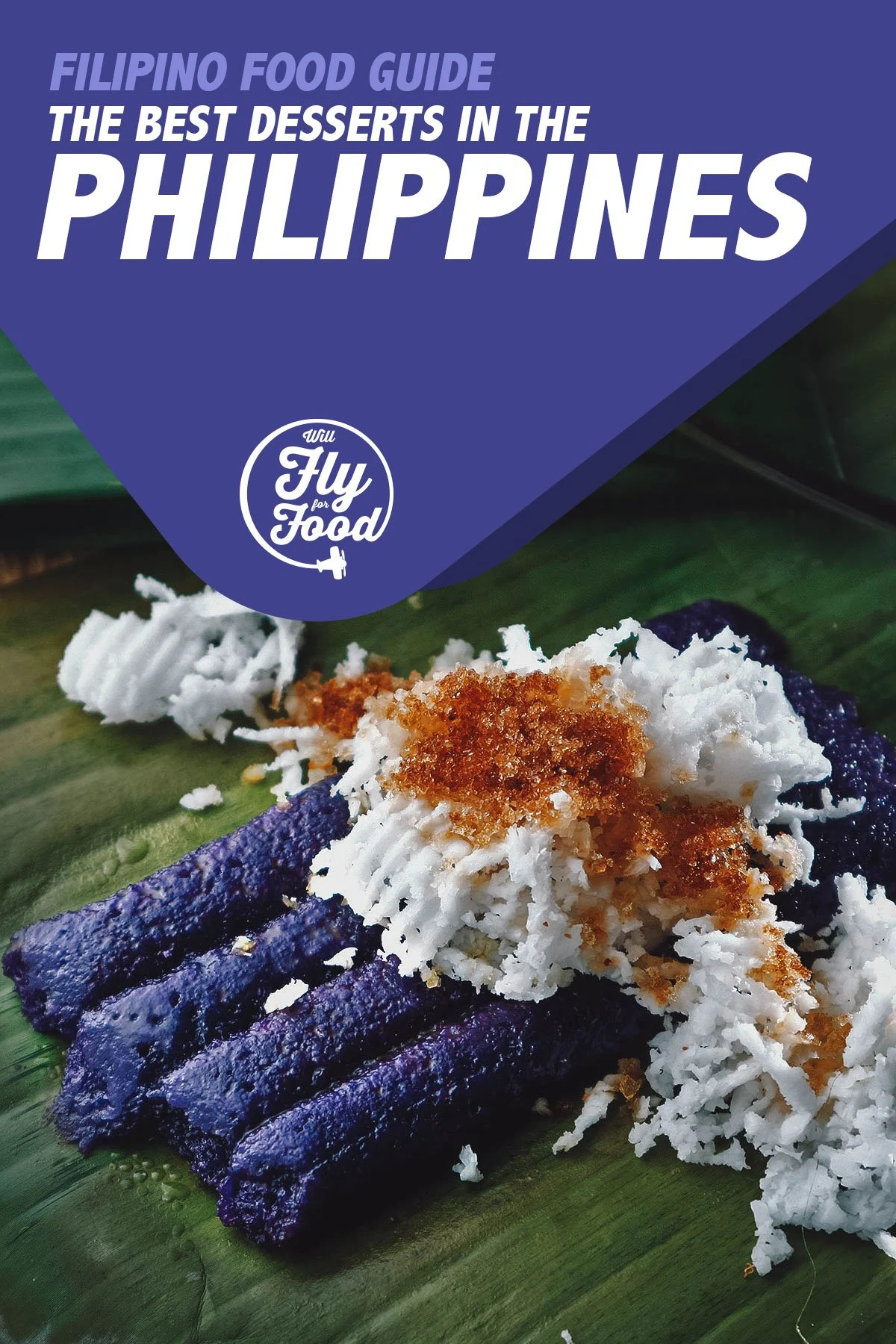
Photo by junpinzon
THE BEST FILIPINO DESSERTS
1. Puto
There’s no better way to start this guide on Filipino desserts than with puto, one of the most famous dessert snacks in the Philippines. It’s one of the most iconic Filipino dishes you can think of and something that’s enjoyed everywhere in the country.
Puto refers to small steamed rice cakes made with slightly fermented glutinous rice dough (galapong). It’s the most popular form of kakanin – a family of Filipino desserts or snacks made with glutinous rice paste. Kakanin is derived from the Filipino word kanin, meaning “rice”, and can be thought of as the Filipino version of Indonesian or Malaysian kuih.
The most basic form of this steamed rice cake is white in color (putong puti) but it does come in different hues depending on what it’s made with. For example, puto made with pandan leaves is green (putong pandan), puto made with ube is purple (putong ube), and puto made with cheese is yellowish in color and typically comes with a thin sliver of cheese on top (putong queso, pictured below).
Traditionally sold in bilaos or woven trays in the Philippines, these steamed rice cakes are typically enjoyed on their own for merienda (afternoon snack) or as an accompaniment to savory dishes like dinuguan (pork blood stew).
If you’d like to make putong puti at home, then you can try this recipe. Puto is traditionally made by soaking glutinous rice in coconut milk and then grinding it into a paste using a stone mill, but versions made in modern kitchens often use glutinous rice flour instead. It’s much easier but not quite as good.
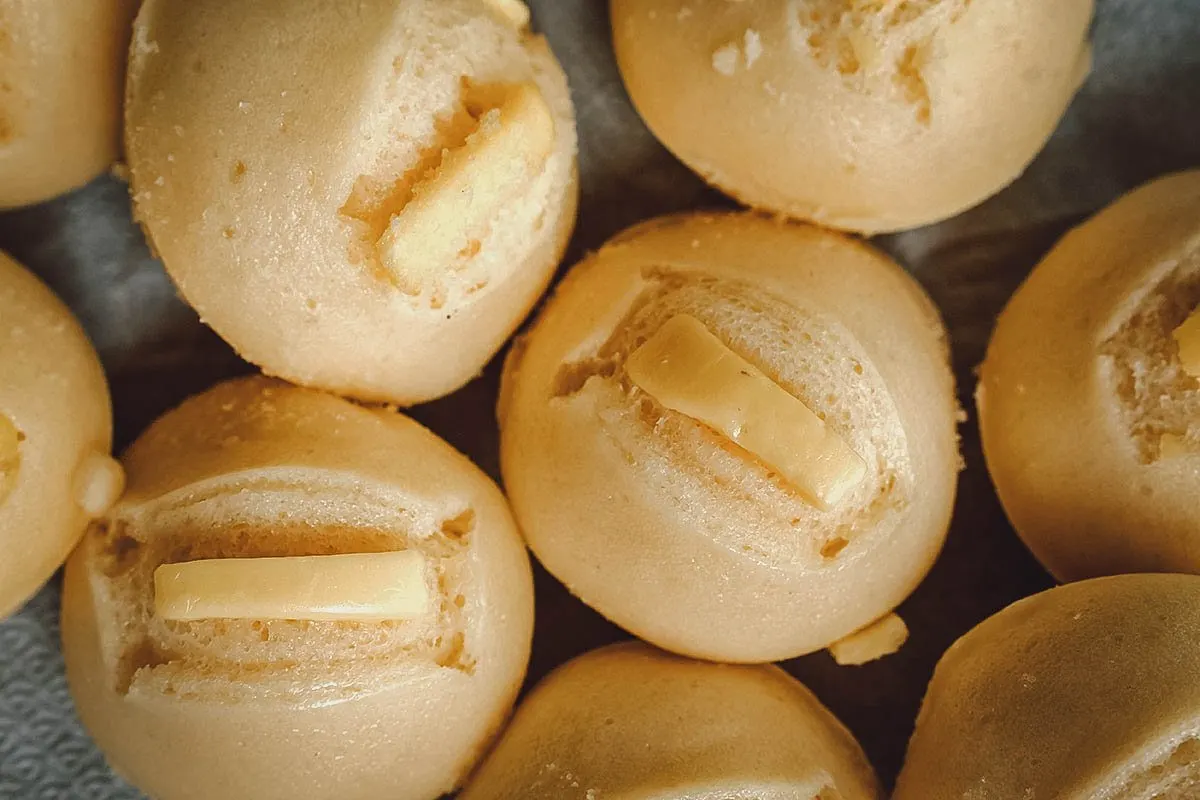
Photo by MikeEdwards
2. Kutsinta
If putong puti is Batman, then putong kutsinta is Robin. Often sold and enjoyed together, this orange variation of the classic Filipino steamed rice cake is just as popular and every bit as delicious. In fact, it was my favorite type of kakanin growing up in the Philippines.
Flatter in shape and orange-ish in color, kutsinta may look very different from the classic version of the iconic rice cake but it’s actually quite similar. It’s made with the same basic ingredients but with the addition of lye which gives it a much chewier and stickier texture. White sugar is substituted with brown sugar and anatto seeds (achuete) are used for color.
Unlike puto that’s typically eaten on its own, kutsinta is always paired with shredded coconut. Kutsinta can be classified as a type of puto, hence the name putong kutsinta, but Filipinos usually refer to it simply as kutsinta. This sticky rice cake is absolutely delicious and still one of my favorite dishes to snack on in the Philippines.
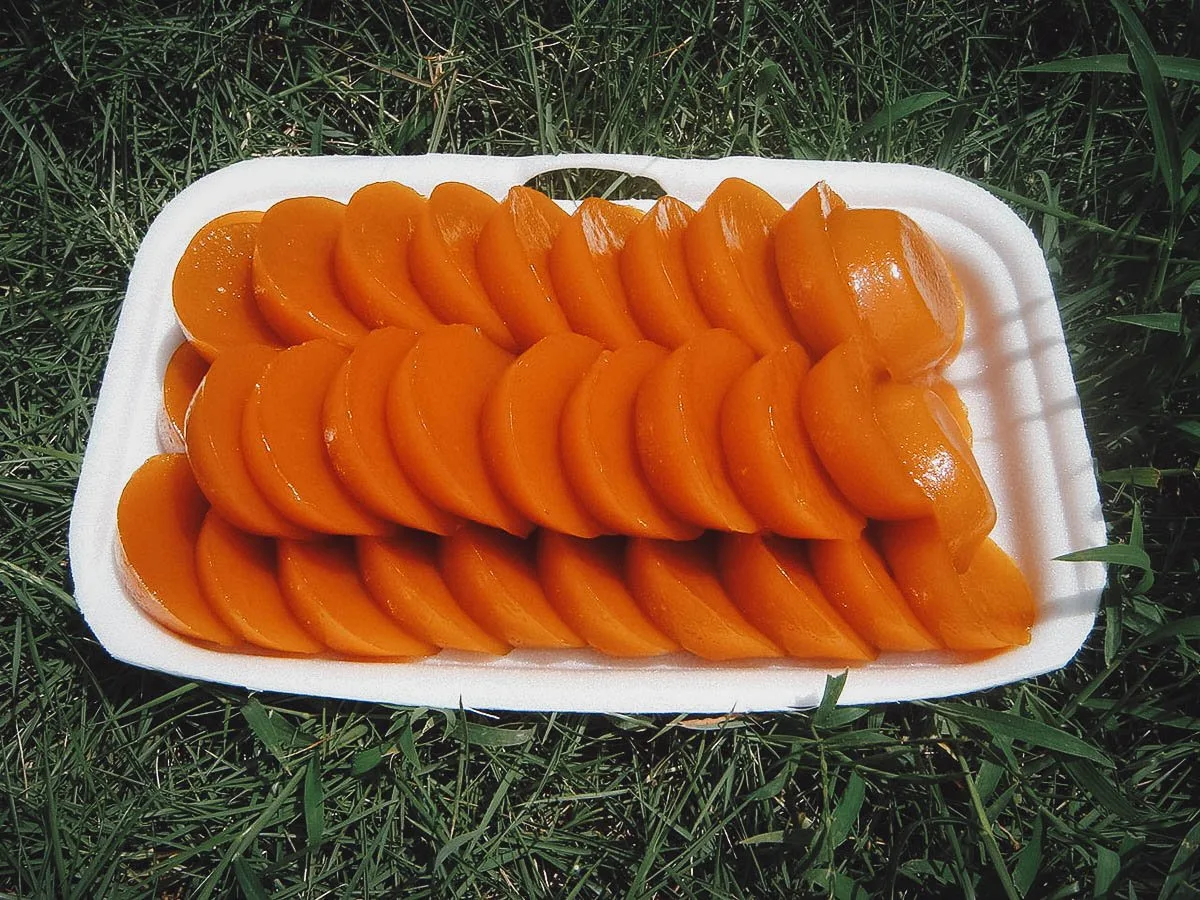
Photo by Ramon FVelasquez, CC BY-SA 3.0, via Wikimedia Commons / Processed in Photoshop and Lightroom
3. Pichi-Pichi
If you like kutsinta, then you’re probably going to enjoy this next Filipino dessert as well. Pichi-pichi (or pitsi-pitsi) is a type of cassava cake made with cassava flour, sugar, and lye. Commonly flavored within pandan leaves, it has a similar texture to kutsinta and is typically rolled in grated coconut or topped with cheese and/or latik before serving.
Even though pichi-pichi isn’t made with glutinous rice, it’s still considered a type of kakanin in the Philippines. It has no bearing on the flavor but food coloring is often added to create different-colored versions of this popular cassava cake.
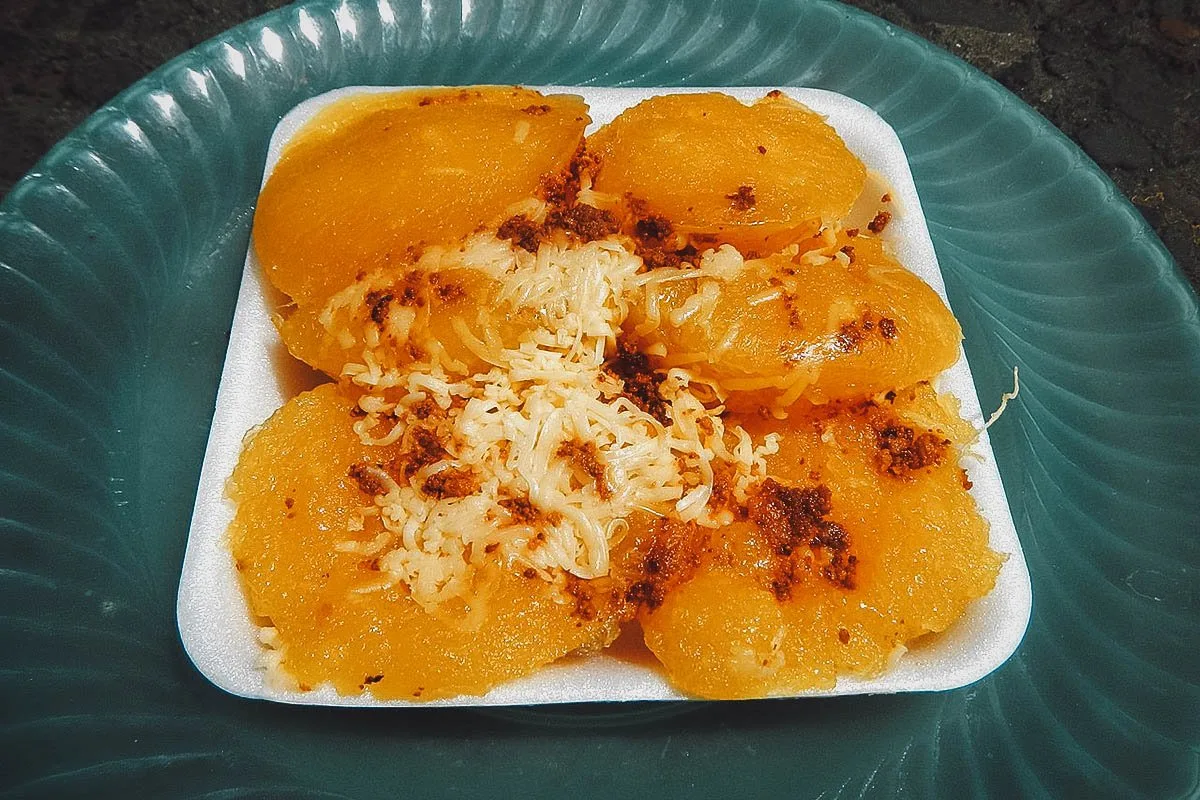
Photo by Judgefloro, CC0, via Wikimedia Commons / Processed in Photoshop and Lightroom
4. Suman
Like puto, suman is one of the most iconic and widely available types of kakanin in the Philippines. It refers to a type of Filipino rice cake made from sticky rice cooked in coconut milk and steamed in banana leaves.
Like puto, suman can be found in many forms throughout the country. The most common varieties are typically shaped like a cigar and served with a sprinkling of sugar on top or drizzled with latik, a type of dark coconut caramel sauce made with coconut milk and brown sugar.
Unfortunately, I’m only familiar with the most basic kinds like suman malagkit (literally “sticky suman”), but travel through the Philippines and you may get to try more interesting varieties made with ingredients like black rice, chocolate, and pinipig (toasted and pounded grains of immature glutinous rice).
No matter what it’s made with, suman is an important and delicious Filipino dessert that’s typically enjoyed for breakfast or as an afternoon snack.
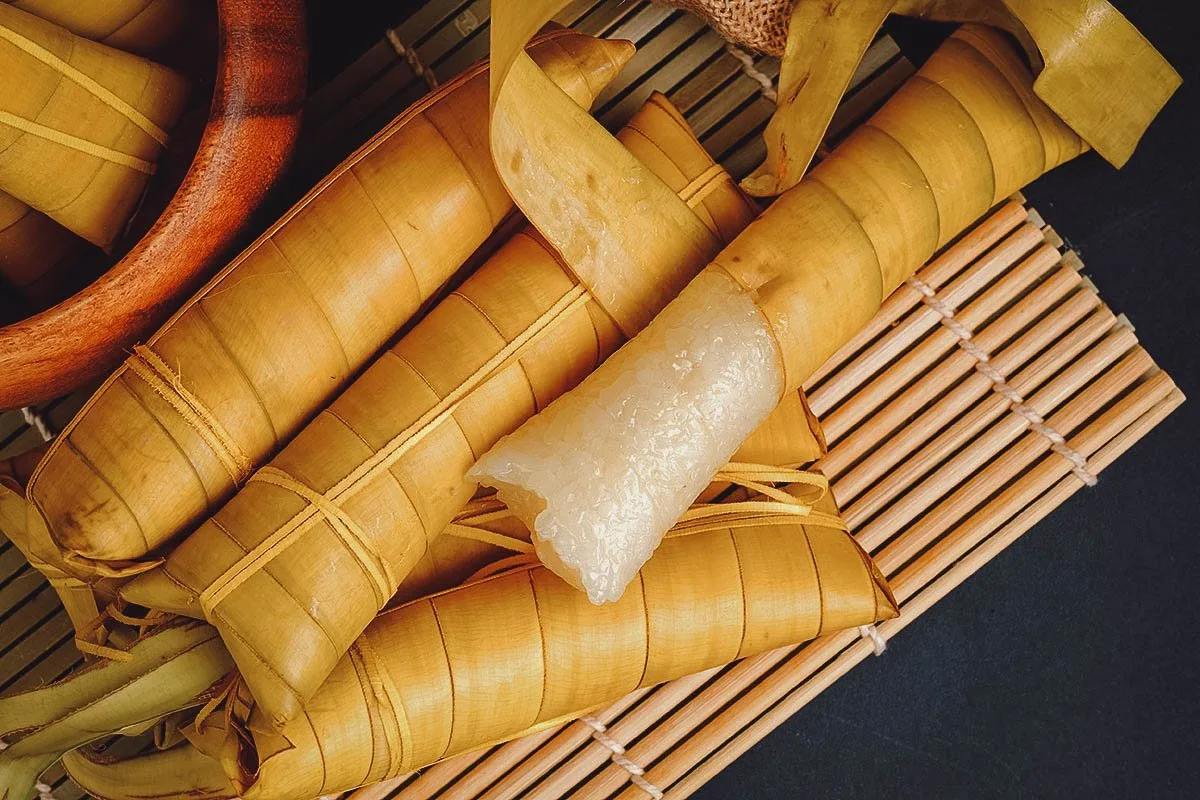
Photo by hendraxu
5. Sapin-Sapin
Isn’t this pretty? Sapin-sapin is one of the most colorful and eye-catching types of kakanin. The name literally means “layered” in Tagalog and refers to the brightly-colored layers that make up this classic Filipino dessert.
Sapin-sapin is made with glutinous rice flour, coconut milk, and sugar. Lesser versions use just food coloring to achieve the different layers but the most lovingly made versions of this delicious dessert are flavored with ingredients like ube, langka (jackfruit), and pureed corn. It’s usually topped with latik and toasted desiccated coconut before serving.
It’s worth noting that the latik mentioned here is different from the latik that’s often drizzled over suman. Depending on where you are in the Philippines, the word latik can mean either the coconut caramel sauce or coconut curds. Latik coconut curds are made by reducing coconut milk to oil and solids and then frying the solids in the oil till golden brown.
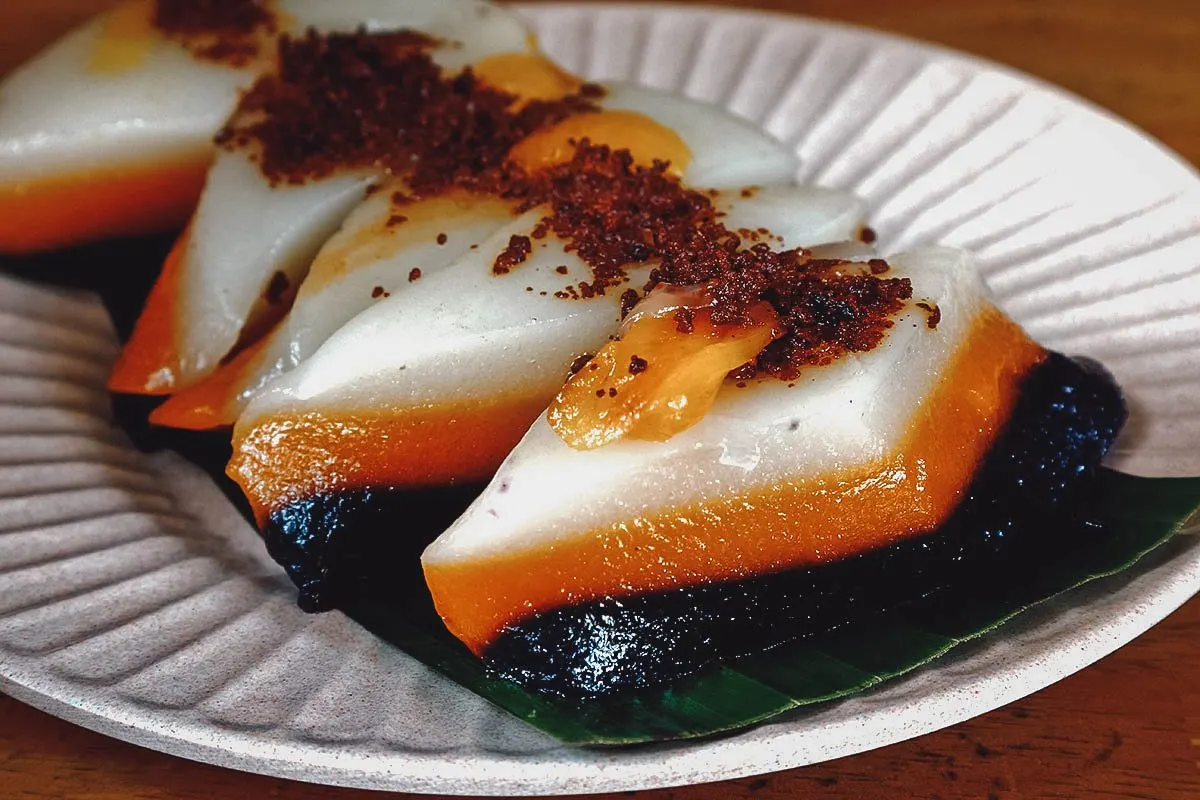
Photo by junpinzon
6. Puto Bumbong
Visit the Philippines around Christmas time and you may get to try puto bumbong, a festive Filipino dessert known for its deep purple color. Traditionally associated with the Christmas season, puto bumbong is one of the prettiest types of kakanin in the Philippines and something I always associate with the holidays.
Because of its rich purple color, many people think that puto bumbong is made with ube (purple yam) but it isn’t. It gets its purple color from pirurutong which is a unique heirloom variety of glutinous rice that’s naturally deep purple to almost black in color.
Puto bumbong is made by steaming the purple rice mixture in bamboo tubes and then serving it on banana leaves. It’s typically slathered with butter or margarine before being topped with muscovado sugar and shredded coconut.
Yes, it’s every bit as delicious as it looks.
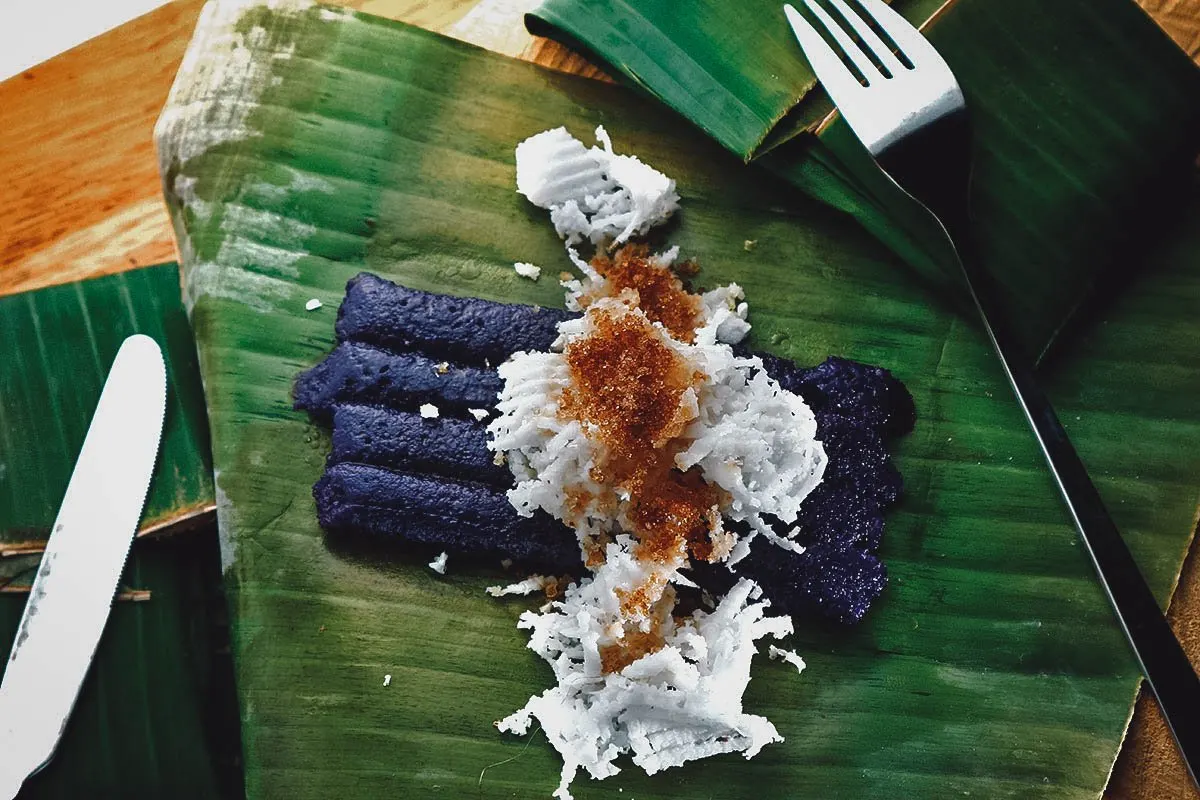
Photo by junpinzon
7. Bibingka
Like puto bumbong, bibingka is a classic Filipino dessert with strong ties to the holidays. It’s available year-round but it’s a dessert that’s traditionally eaten around Christmas.
Like the previous Filipino desserts on this list, bibingka is a type of kakanin though it’s a bit different from the others because it’s baked instead of steamed. It’s made with a glutinous rice and coconut milk batter poured in a clay pot lined with banana leaves. The pot is sandwiched between two layers of pre-heated charcoal which cooks the batter from the top and bottom.
Bibingka can be made with just batter but the best versions are enriched with slices of salted egg. Typically enjoyed for breakfast or as a snack, especially after simbang gabi, this delicious dessert is usually topped with butter or margarine, sugar, cheese, or shredded coconut.
If you ever find yourself in the Philippines over the Christmas holidays, then I highly recommend trying this dish. I may be biased but for me, it’s one of the most delicious Filipino desserts on this list.
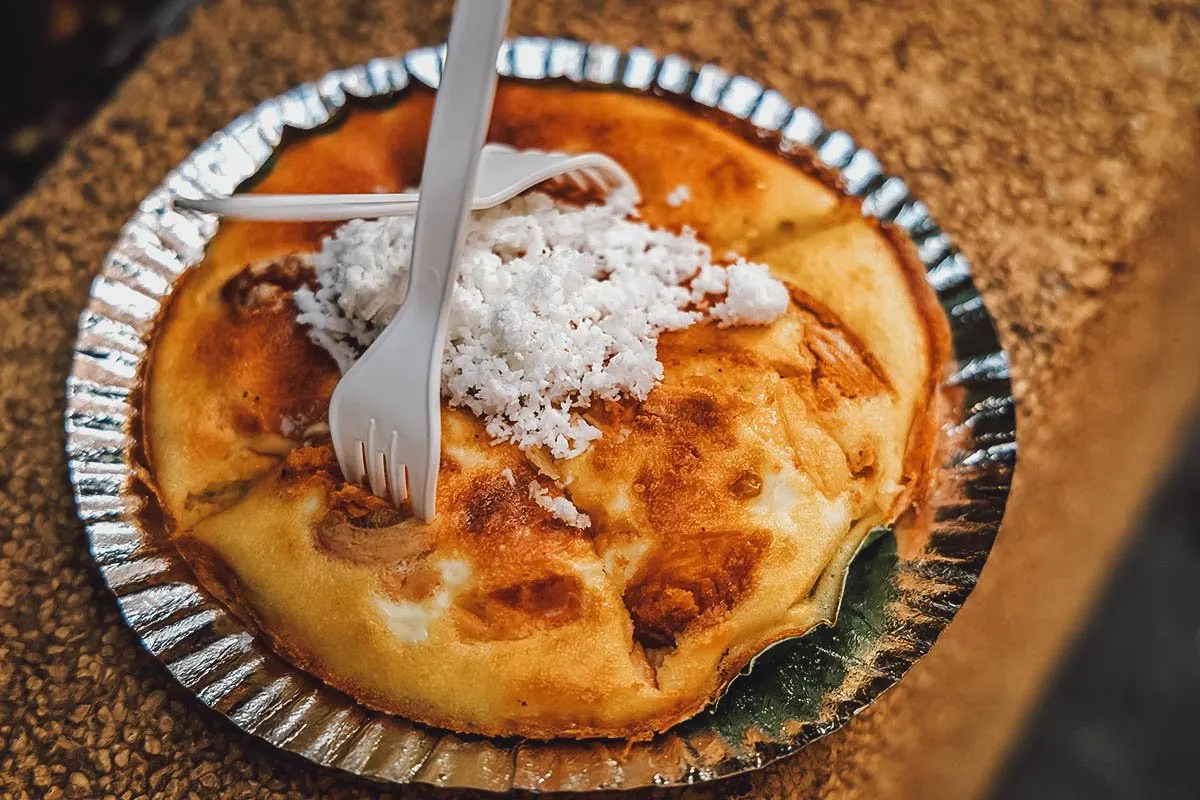
Photo by bugking88
8. Bibingka Malagkit / Biko
This next Filipino dessert used to confuse me as a kid. It shares the same name as my beloved Christmas bibingka but it looks and tastes nothing like it.
Bibingka malagkit literally means “sticky bibingka” and refers to a Filipino rice cake made with cooked glutinous rice topped with caramelized brown sugar and coconut cream. Dense and sticky, it’s actually closer in taste and texture to suman than Christmas bibingka which is probably what caused much of my confusion. In any case, it’s a delicious Filipino dish that’s often enjoyed as an afternoon snack or for dessert.
Depending on which part of the Philippines you visit, you may encounter a similar dessert called biko. It’s also made with sticky rice and looks very similar to bibingka malagkit except it’s topped with latik.
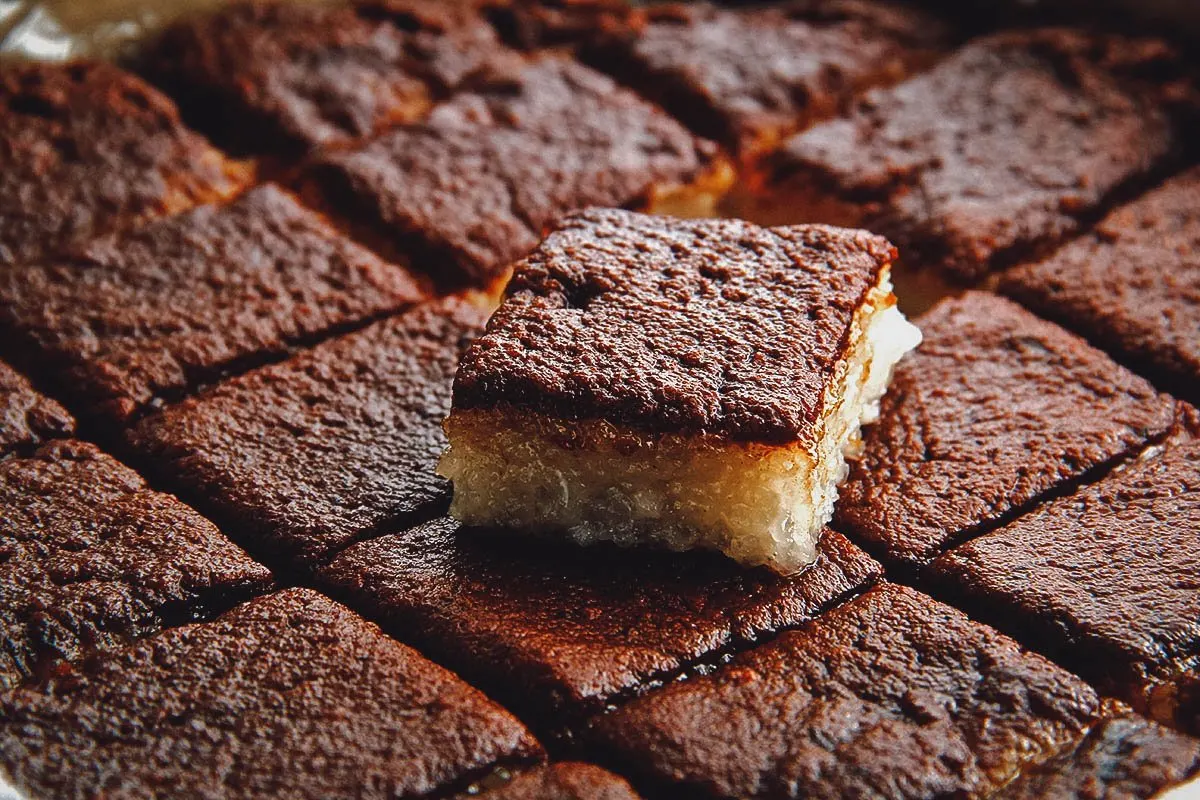
Photo by junpinzon
9. Sans Rival
Sans rival is one of the more interesting cakes or pastries in the Philippines. It’s interesting because it’s different from the usual Filipino desserts.
Sans rival consists of three layers of cashew nut meringue held together with buttercream. After assembling the layers, the cake is coated with more buttercream and topped with chopped cashews before being kept in the freezer to give it a uniquely crunchy and chewy texture.
Meaning “unrivaled” in French, no one really knows where the dish originated from but one theory claims it’s the Filipino version of the French dacquoise. According to the story, many Filipinos traveled to France in the late 19th and early 20th centuries. Some brought cooking techniques back with them which led to the creation of sans rival. The use of cashews differentiates sans rival from the French dessert which is made with almonds and hazelnuts.
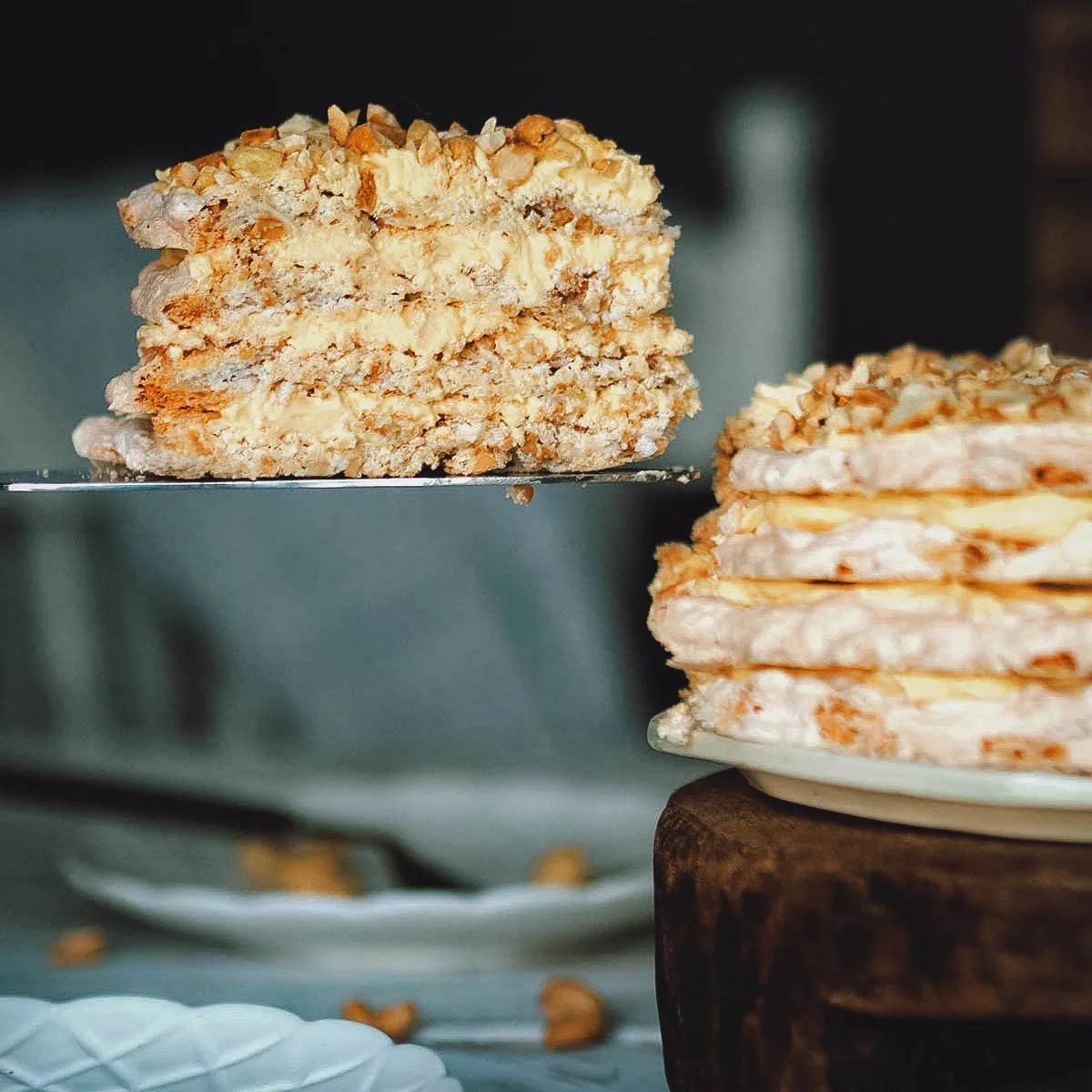
Photo by Sara McCleary, CC BY-SA 4.0, via Wikimedia Commons / Processed in Photoshop and Lightroom
10. Halo-Halo
This festive and colorful dish is one of the most internationally well-known Filipino desserts. Even if you’ve never had it, chances are you’ve at least heard of this Filipino dessert or seen it on social media.
Meaning “mixed” in Filipino, halo-halo refers to a cold and refreshing dessert made with crushed or shaved ice, sweetened condensed milk, and a plethora of additional ingredients like sweetened beans, coconut strips, ube (purple yam jam), sweet corn, kaong (sugar palm fruit), leche flan, sweetened bananas, and ice cream. You can think of it as the Filipino version of Vietnamese che.
Halo-halo is usually served in a tall parfait glass so you can see its multi-colored layers of ingredients. To assemble, it starts with the various ingredients at the bottom followed by shaved ice and sweetened condensed milk. Depending on the restaurant, it can be topped with additional ingredients like leche flan, purple yam jam, and ice cream. Vanilla ice cream is nice but my favorite versions are topped off with a scoop of ube ice cream.
Halo-halo is one of the most photogenic Filipino desserts so be sure to get your Instagram shots before digging in. To eat, you take the long spoon and thoroughly mix up the shaved ice with the other ingredients until you have a colorful sludge of refreshing deliciousness. Many tourists who’ve tried it say that halo-halo is their favorite Filipino dessert.
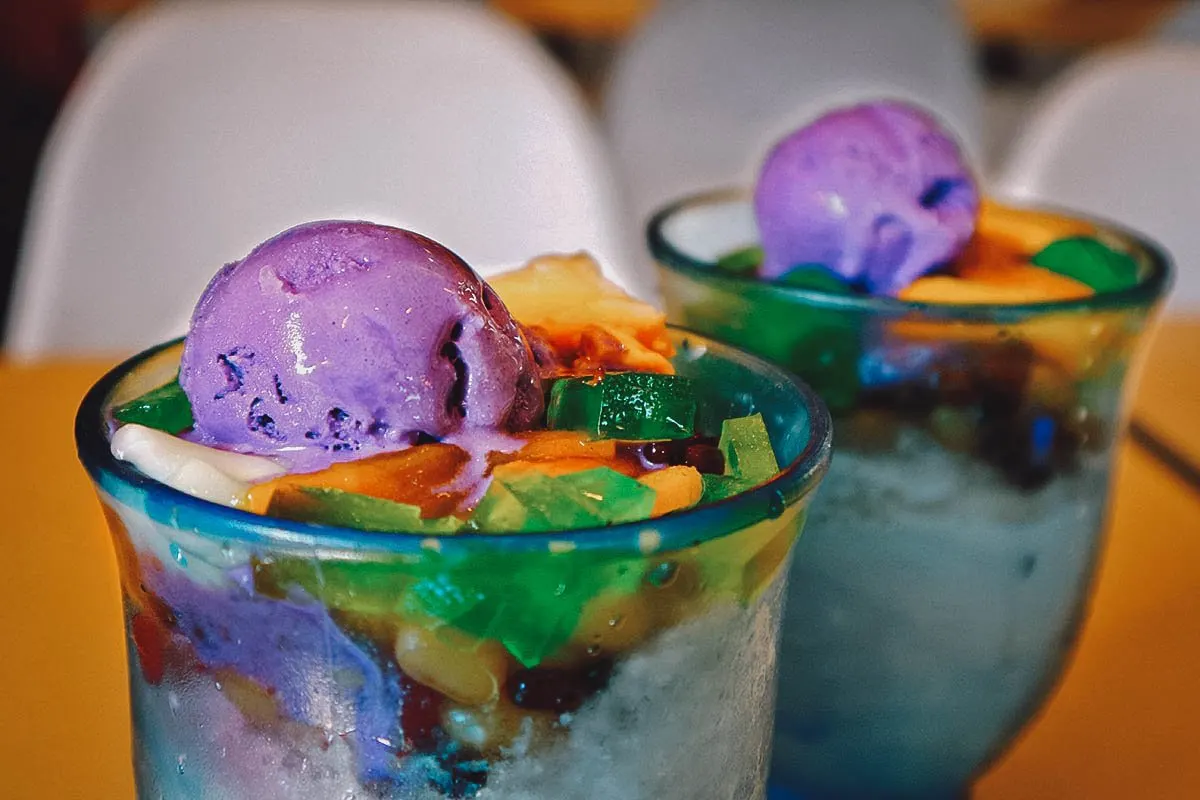
Photo by junpinzon
11. Sorbetes (Dirty Ice Cream)
For me, these colorful ice cream carts are just as iconic a sight in the Philippines as passenger jeepneys. They have those colorful fancy wheels and are often blinged out with hand-painted patterns and ornate fonts. I read that the wheels are always painted yellow so they resemble the sun in our nation’s flag.
Sorbetes refers to the type of Filipino ice cream sold from these mobile street carts. At the time of its invention, it was made with carabao’s milk which was cheaper than cow’s milk. Today, both types of milk are used to make sorbetes along with local ingredients like sweetened coconut milk and cassava flour. Some of the most popular sorbetes ice cream flavors include mango, ube (purple yam), coconut, and our personal favorite – queso (cheese).

Sorbetes is commonly referred to as “dirty ice cream”, perhaps in reference to the way its sold on the street. But there’s nothing dirty about it (as far as I know). It melts faster than your average store-bought ice cream so it’s best to gobble it up as quickly as you can.
Unlike your everyday ice cream that’s typically sold in waffle or sugar cones, dirty ice cream can also be served in bread buns. Yes, bread buns. I know it sounds odd, but the combination actually works! If you’ve been to Singapore, then you may have seen something similar.

Photo by MikeEdwards
12. Ginataang Bilo-Bilo
Ginataan refers to a family of sweet and savory Filipino dishes made with gata or coconut milk. You can sometimes tell if a dish is made with coconut milk because the word “ginataan” is part of its name, like ginataang kuhol (snails cooked in coconut milk), ginataang manok (chicken in coconut milk), and ginataang mais (corn with coconut milk).
In our household, and I believe in many parts of northern Philippines, when someone says just “ginataan”, they’re usually referring to this thick dessert soup made with sweetened coconut milk. Like halo-halo, it can contain any number of ingredients like sweet potato, tubers, sago (tapioca pearls), langka (jackfruit), and sweetened bananas.
My personal favorite are the ones made with sticky rice balls. Known as ginataang bilo-bilo, it can contain any of the ingredients mentioned above plus these delicious chewy rice balls cooked in sweetened coconut milk. These sticky rice balls have a soft and chewy texture that goes so well with the sweet potatoes and tapioca pearls.
Ginataang bilo-bilo can be enjoyed for dessert but since it’s so filling, it’s more commonly enjoyed as an afternoon snack. It’s traditionally served hot though it can be served cold as well.
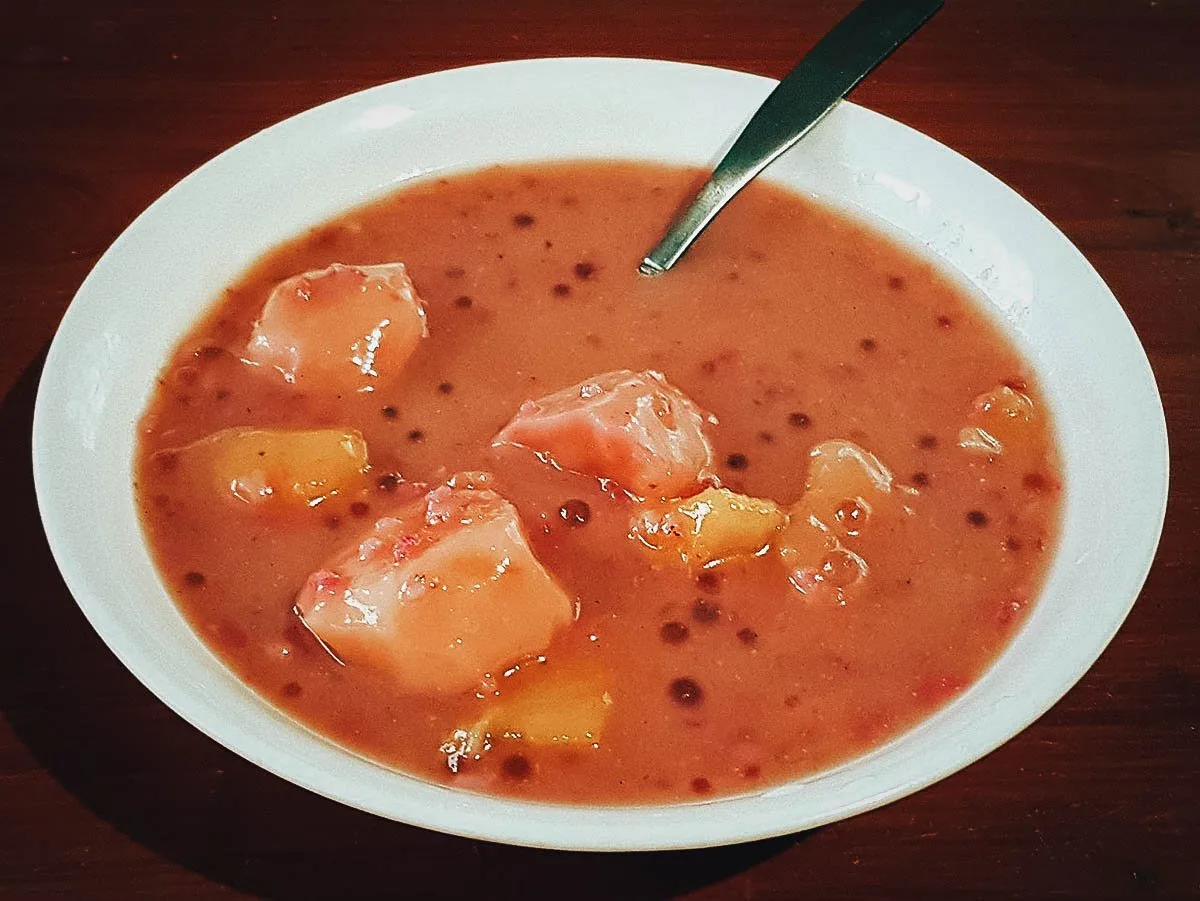
Photo by Obsidian Soul, CC0, via Wikimedia Commons / Processed in Photoshop and Lightroom
13. Taho
Taho is a classic Filipino dessert that brings back fond childhood memories for many Filipinos. It’s the Filipino version of douhua, the popular Chinese snack of silken tofu served in many parts of Asia. It exists in different versions throughout the continent but in the Philippines, it consists of three ingredients – silken tofu, tapioca pearls, and arnibal (brown sugar syrup).
Filipinos from the suburbs grew up eating this traditional dessert. Everyday, either in the morning or in the afternoon, the taho vendor would ply the neighborhoods and yell out “tahoooo!” while carrying two aluminum buckets on either side of a bamboo pole. One bucket contained the silken tofu while the other carried the tapioca pearls and brown sugar syrup.
Taho can be enjoyed for dessert, but depending on when the taho vendor would pass by your house, we’d typically have it for breakfast or as an afternoon snack. Silken tofu can be served cold or hot but in the Philippines, it’s more commonly served hot or at room temperature.
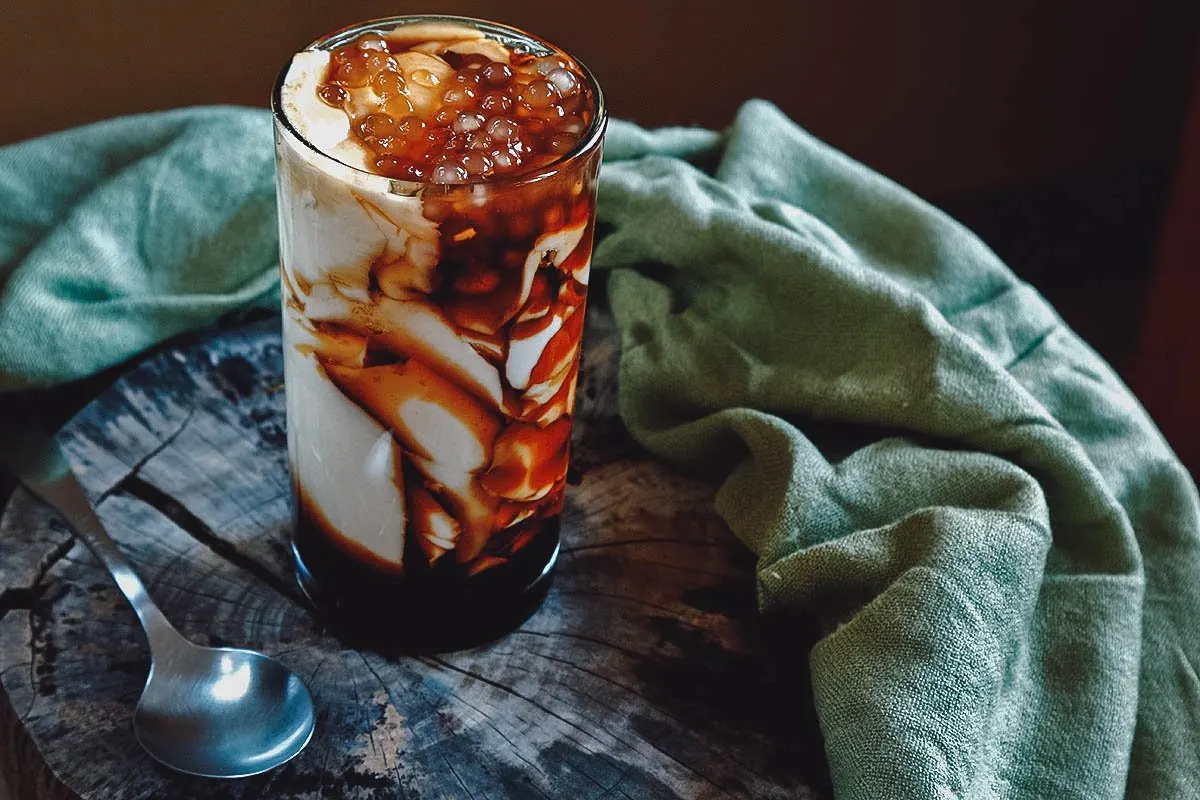
Photo by junpinzon
14. Leche Flan
Leche flan is one of the most popular and beloved Filipino desserts. Unless they’re dead, you’d be hard-pressed to find someone who didn’t enjoy the taste and silky soft texture of this incredibly delicious Filipino caramel pudding.
As you can probably tell, leche flan is the Filipino version of flan or creme caramel, a popular dessert made with sweetened condensed milk and lots of egg yolks. It exists in many countries throughout the world like Spain, Portugal, Argentina, and Brazil.
In the Philippines, leche flan is usually made in an oval-shaped tin mold called a llanera. This soft and creamy dessert is hugely popular in the Philippines and something you’d typically find at a Filipino party or family gathering. Luckily for tourists, leche flan is served at many Filipino restaurants as well.
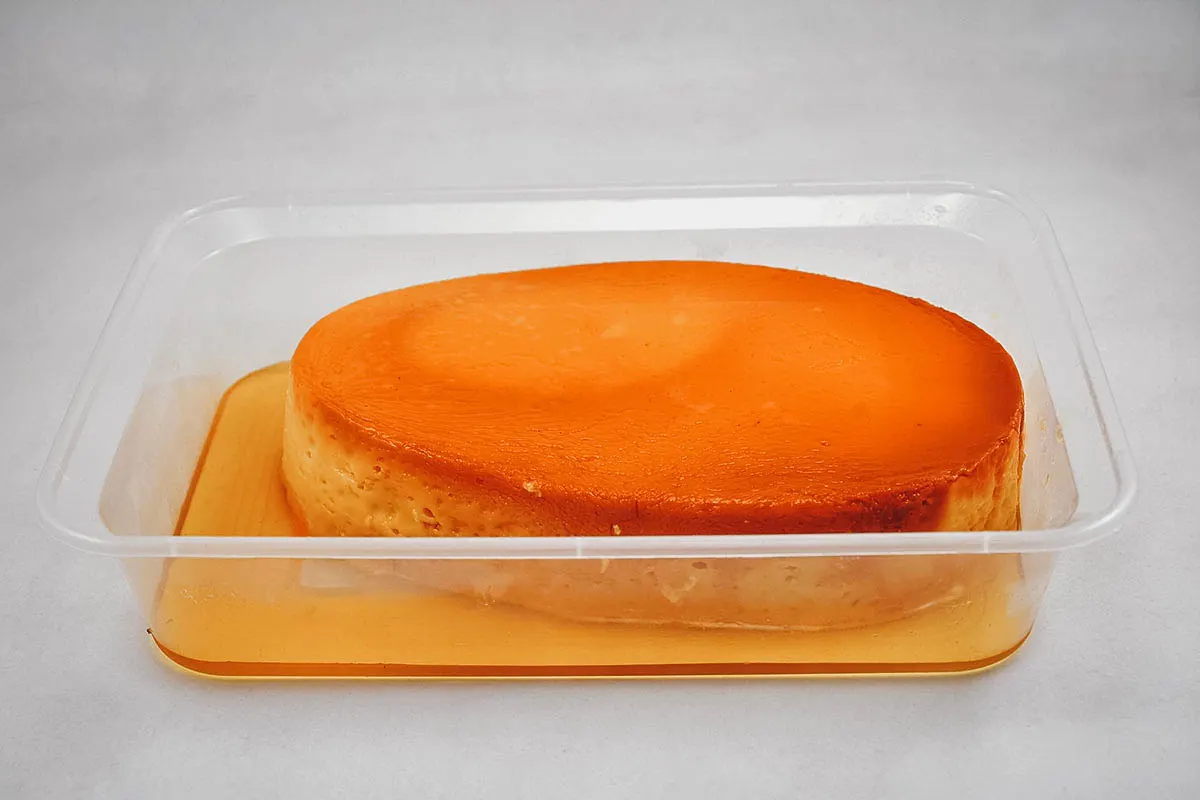
Photo by imwaltersy
15. Turon
Like leche flan and taho, turon is an iconic dessert that many Filipinos grew up eating. It refers to a popular Filipino snack or dessert made with thin slices of plantain dusted with brown sugar and deep-fried in lumpia wrapper. This delicious treat is commonly sold as street food in the Philippines though it’s often enjoyed at home as well, either for dessert or as an afternoon snack.
Turon is usually eaten at room temperature but personally, I like it best when it’s served hot and with a side of vanilla ice cream. It’s so delicious!

Photo by asimojet
16. Banana Cue
Like turon, banana cue is one of the most popular Filipino desserts commonly sold as street food. It refers to skewered deep-fried plantains coated in caramelized brown sugar.
Filipinos love plantains and banana cue and turon are the two most widely consumed Filipino desserts made from these mildly sweet cooking bananas. Depending on who’s making them, they can both be dusted with toasted sesame seeds for added nuttiness.
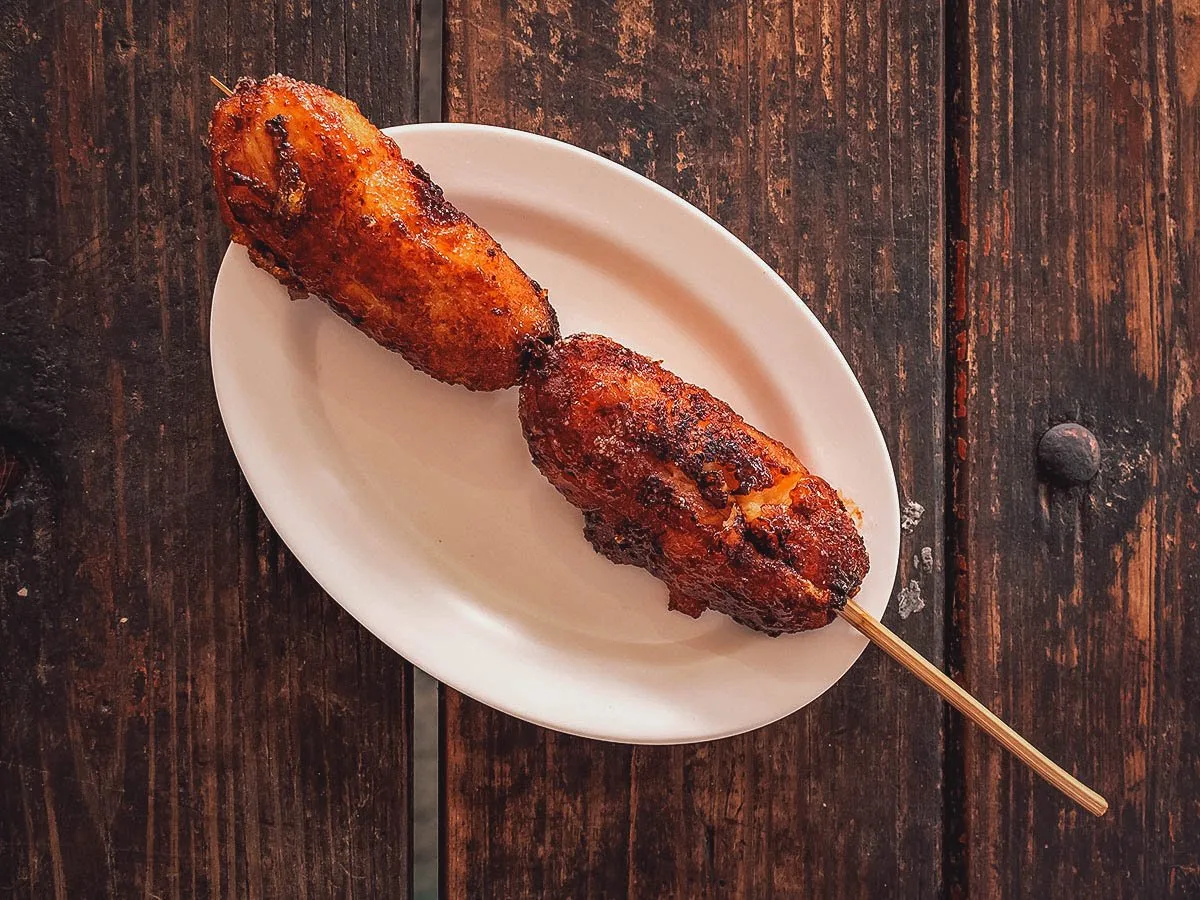
Photo by MikeEdwards
If you come across a vendor selling banana cue, then chances are he’ll be selling kamote cue as well. Kamote cue is a similarly skewered and deep-fried street food dessert made with sweet potatoes.
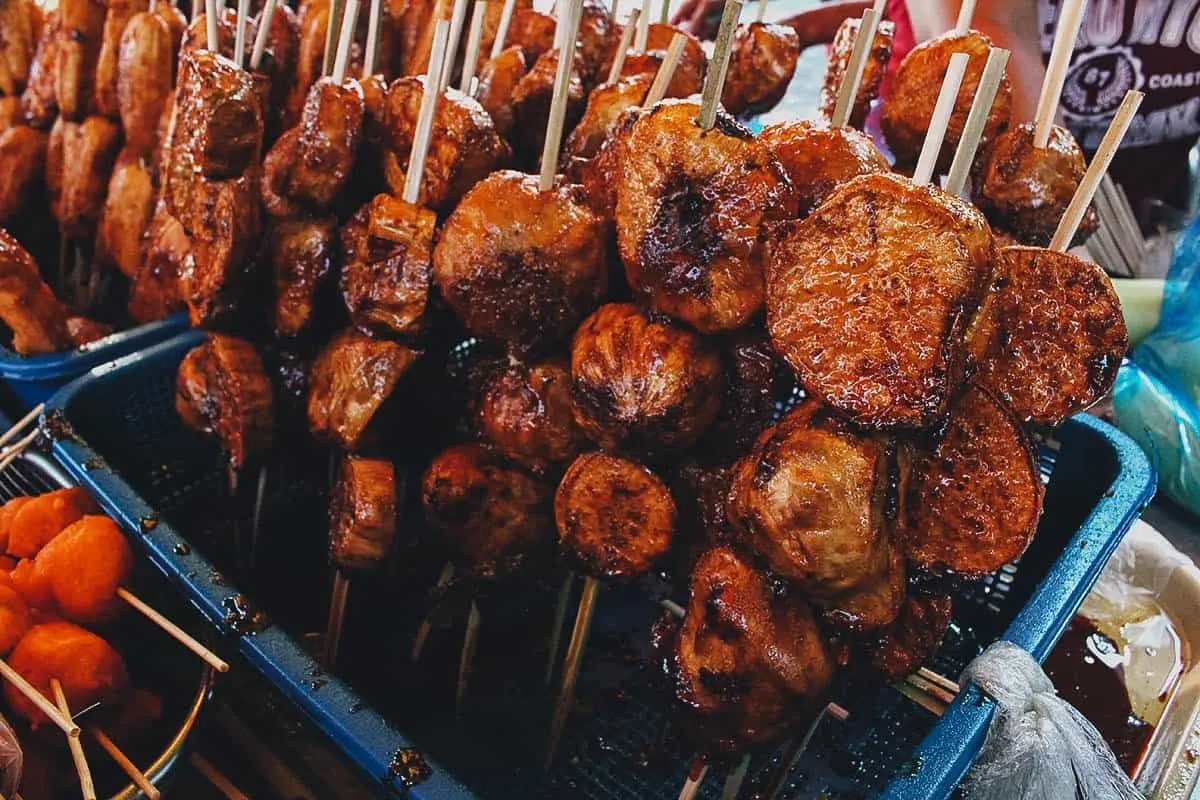
17. Minatamis na Saging
Minatamis na saging literally means “sweetened banana” and refers to a simple but delicious dessert made with chopped plantains cooked in arnibal (brown sugar syrup). Depending on the cook, other ingredients like sweet potato, jackfruit, and sago may be added as well.
Minatamis na saging can be eaten on its own but it’s also frequently used as an ingredient in other Filipino desserts like halo-halo. When served with shaved ice and evaporated milk, it becomes known as saba con yelo (literally “banana with ice”).
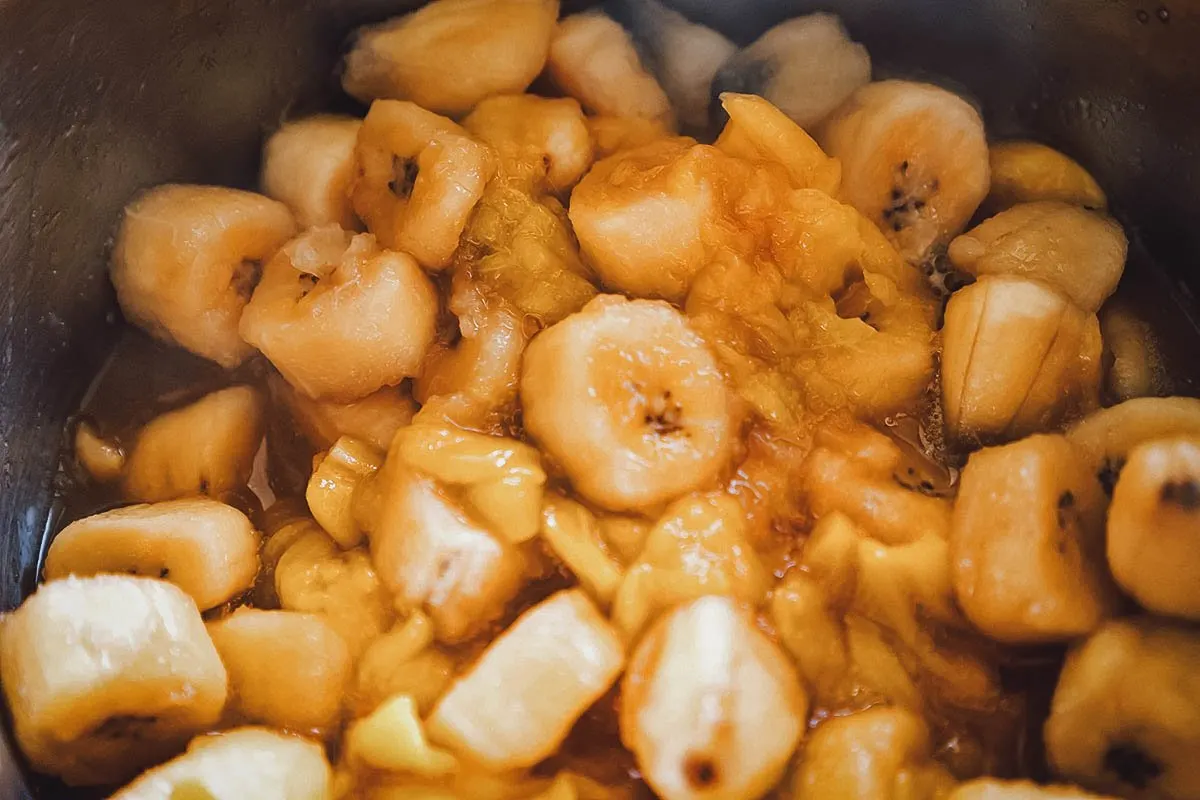
Photo by [email protected]
18. Ensaymada
With the Philippines being a Spanish colony for over 300 years, it’s no suprise that many Filipino dishes have Spanish roots. Ensaymada is one of them. It’s originally a Mallorcan dish that’s become a staple snack or dessert in Filipino cuisine.
Ensaymada is a type of Filipino brioche bread baked with butter and topped with buttercream and grated cheese, usually queso de bola (edam). The name ensaymada stems from the root word saim, meaning “pork lard”. Spanish ensaimada is made with pork lard but the Filipino version is made with butter instead.
Like bibingka and puto bumbong, ensaymada is traditionally associated with the holiday season though it’s widely available at any time of the year. Over Christmas, people often gift friends and relatives with boxes of special ensaymada. It has a light and fluffy consistency and is commonly eaten for breakfast or as an afternoon snack.
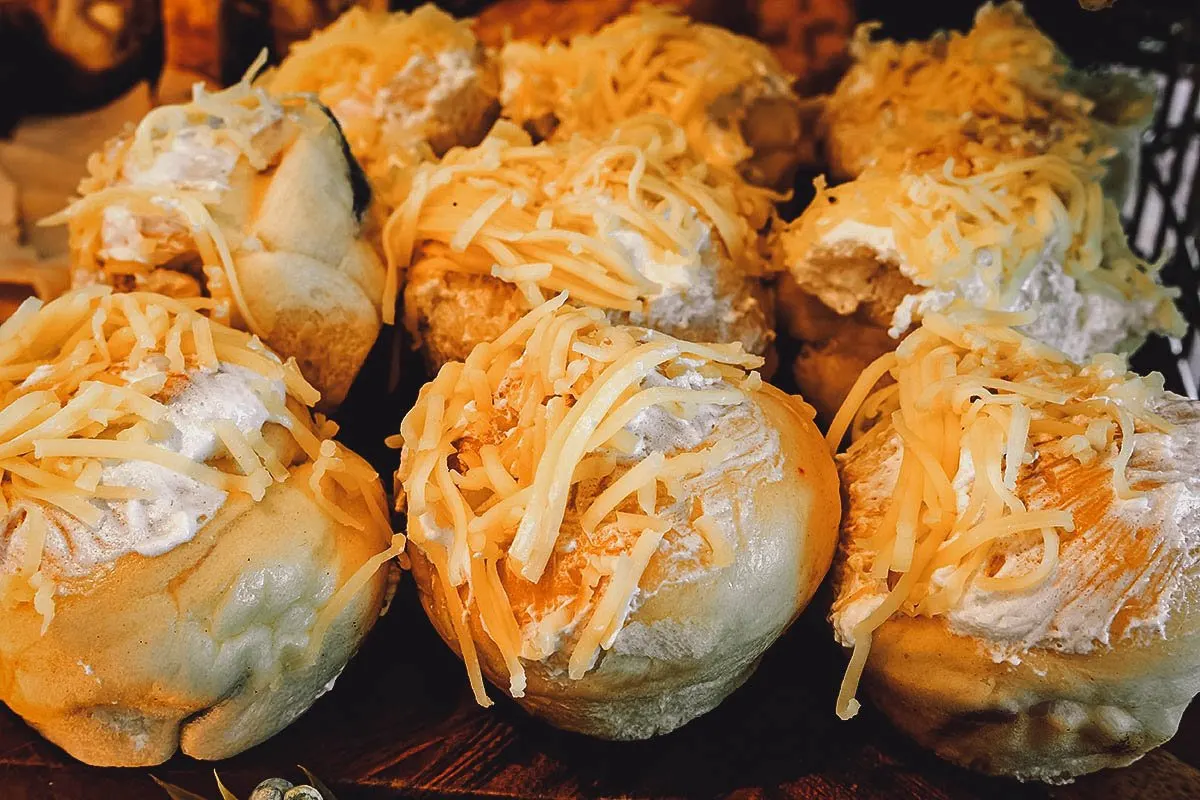
Photo by MikeEdwards
19. Polvoron
Like ensaymada, polvoron is a Filipino dessert that was introduced to the Philippines by the Spanish colonists. Its name stems from the Spanish word polvo, meaning “powder” or “dust”, and is in reference to the dessert’s soft and very crumbly texture.
Spanish polvoron is made with flour, sugar, milk, and nuts while the Filipino version is made with a large amount of powdered milk, toasted flour, sugar, and butter or margarine. It can be flavored with other ingredients as well like ube (purple yam), strawberry, pinipig (toasted rice), and cashew.
Polvoron is milky and delicious but it’s also chalky and dry. TV game shows and house parties would have parlor games where participants would put polvoron in their mouths and try to whistle. It’s not easy!
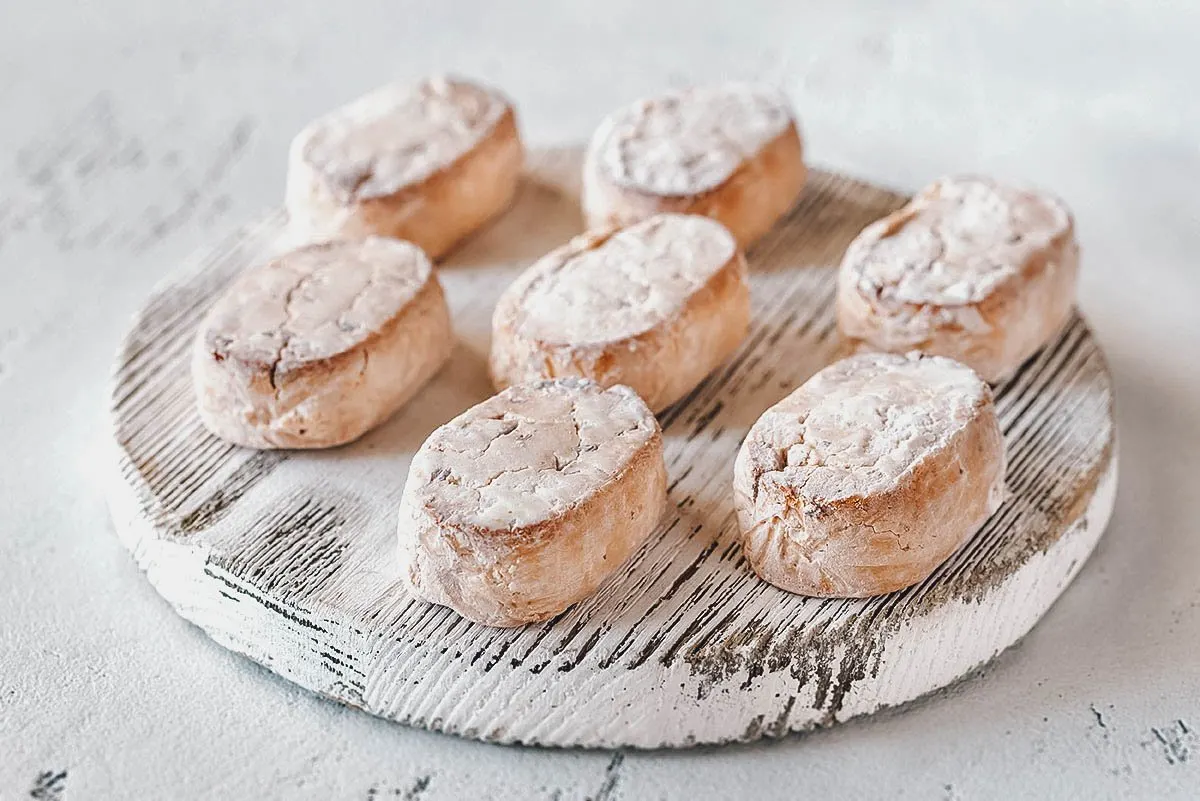
Photo by PantherMediaSeller
20. Pan de Coco
Visit a neighborhood bakery in the Philippines and you’ll find many different types of locally made pastries and bread. Pan de coco is one of the most well-known and something that you’ll find in most of these Filipino bakeries.
Pan de coco literally means “coconut bread” and refers to a type of sweet bread stuffed with a filling of grated coconut, brown sugar, butter, and coconut milk. It’s said to be Honduran in origin and made its way to the Philippines via the Spanish colonists.
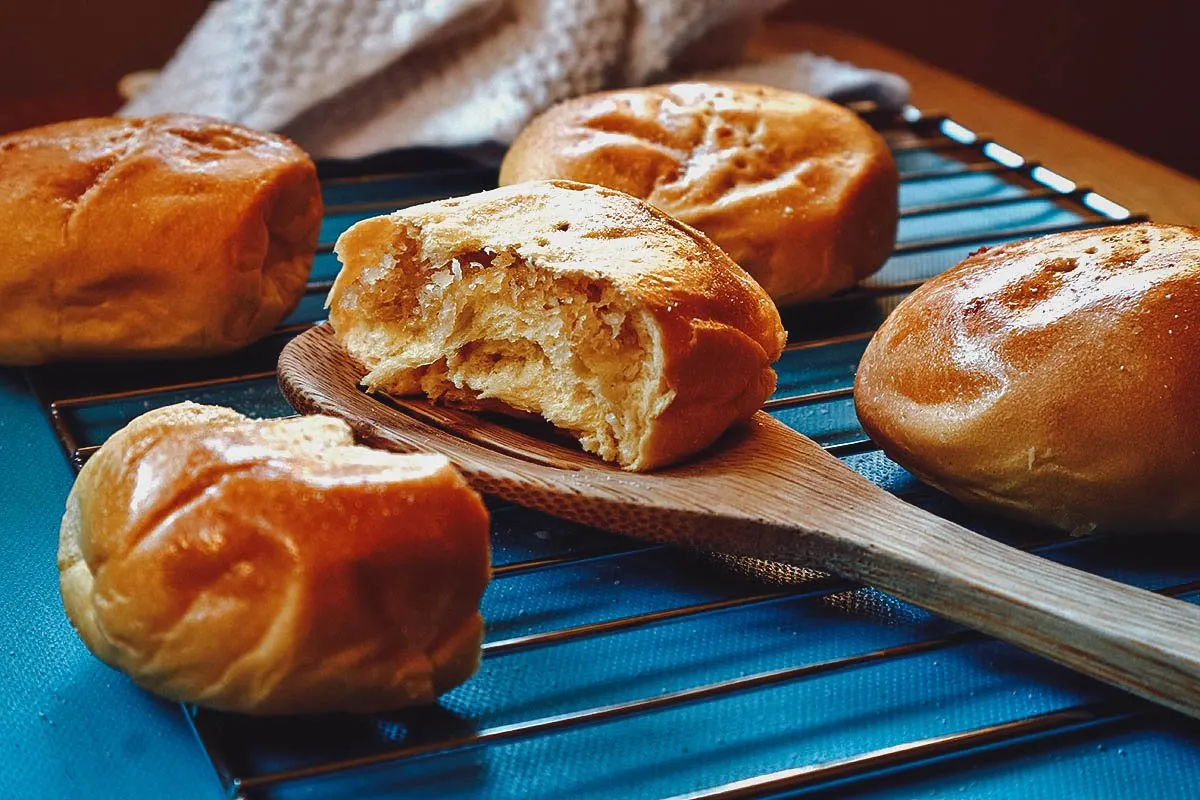
Photo by junpinzon
21. Buko Pie
Buko means “coconut” in Filipino. This versatile Filipino fruit is a vital part of the local cuisine and can be prepared in a number of ways. It can be enjoyed fresh, made into toppings or sauces, or used as a filling. For me, one of the most delicious Filipino desserts made with coconut is buko pie.
A specialty of Laguna province in Luzon, buko pie is made with young coconut meat mixed with a creamy, custard-y filling and enclosed in a flaky pie crust. You can think of it as the Filipino equivalent to American apple pie, which is exactly what inspired it.
According to the story, a Filipina working in the US learned how to make apple pies so she wanted to create something similar on her return to the Philippines. Apples aren’t native to the Philippines so she substituted them with young coconut meat, and so was born this delicious and now very famous coconut dessert.
Creamy and custard-y, buko pie is a mildly sweet dessert with the tropical flavors of coconut. Like its inspiration apple pie, its absolutely delicious when served hot from the oven and topped with a scoop of vanilla ice cream.
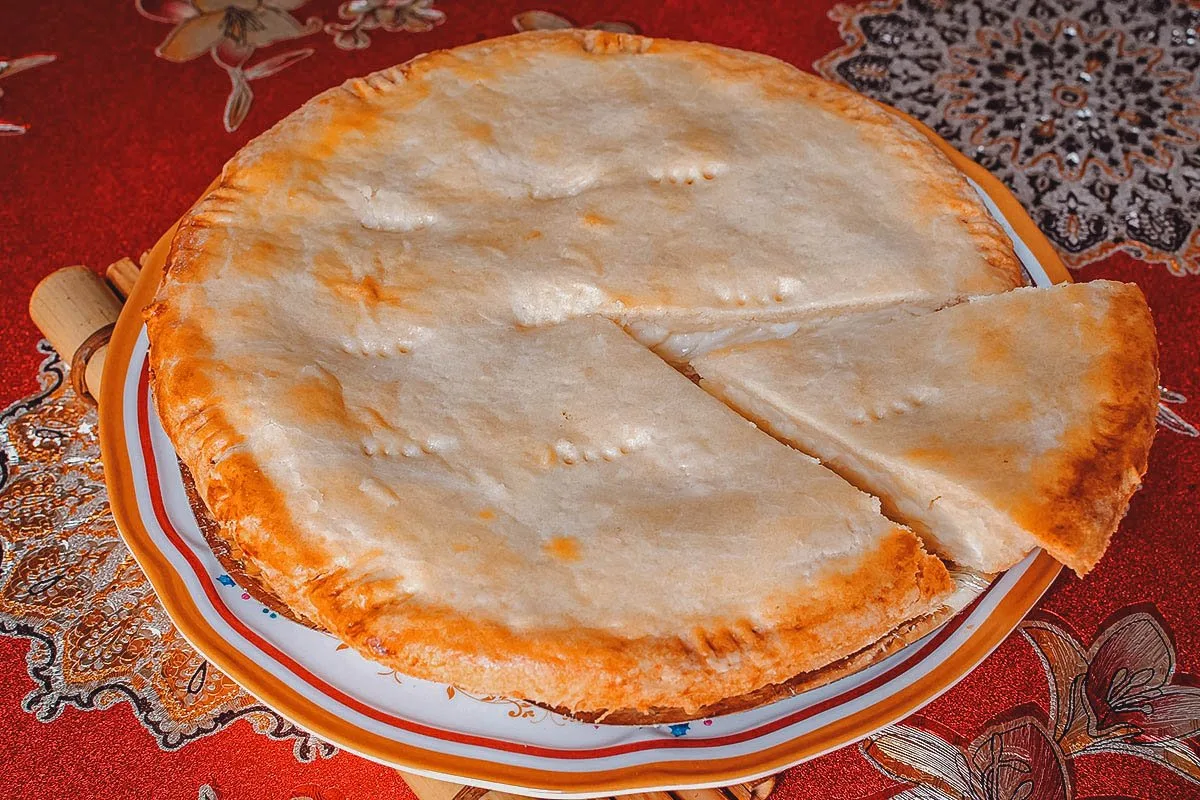
Photo by MikeEdwards
22. Egg Pie
Egg pie is exactly what it sounds like, a sweet dessert made with egg. It’s basically a delicate but firm egg custard dessert served in a buttery and flaky pie crust. In a way, it’s the Filipino version of a Portuguese pastel de nata or a Hong Kong egg tart, but for sharing.
I love the simplicity of Filipino egg pie. It’s firm enough to eat using only your hands and is usually available at the same neighborhood bakeries that sell Filipino pastries and breads like pan de coco.
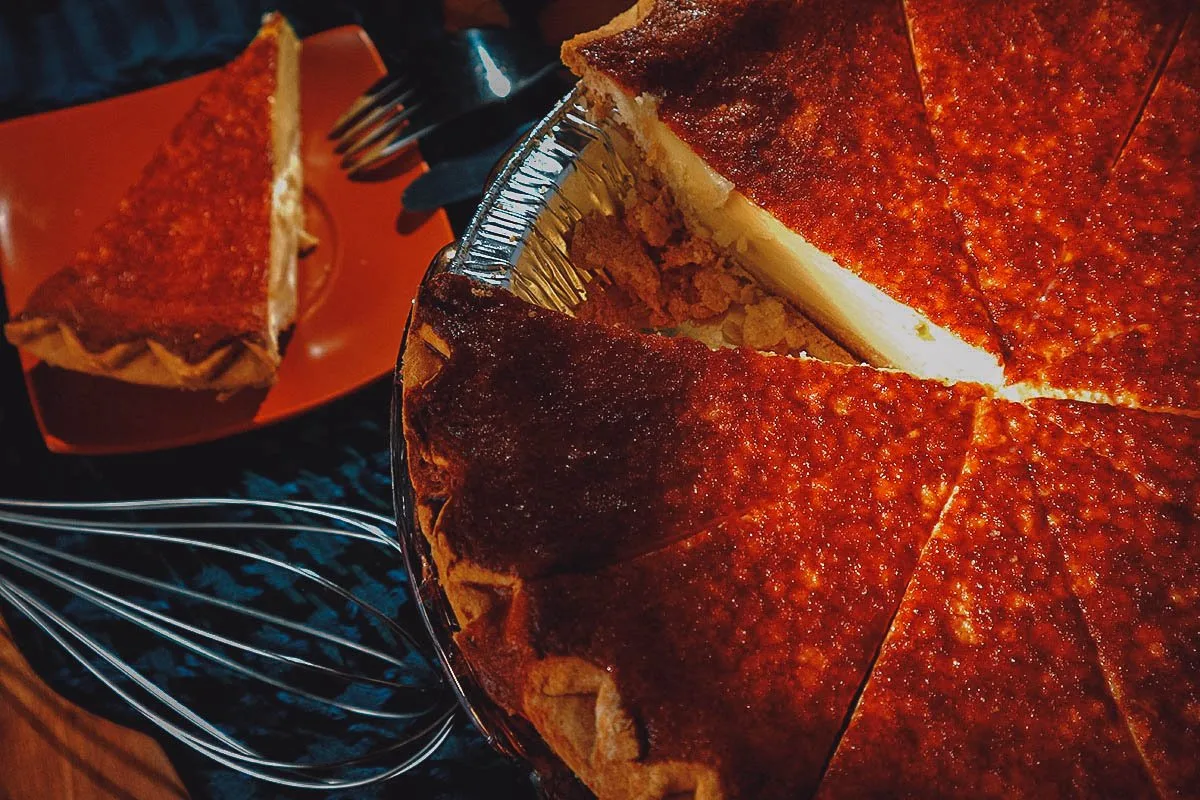
Photo by junpinzon
23. Buko Pandan
If you’re like me and enjoy the scent of coconut and pandan, then you’re going to love this next dessert. As you can tell from its name, its made from coconut meat and pandan leaves, a fragrant pairing that comes together beautifully in this cold and refreshing dessert.
Buko pandan is a popular Filipino dessert made with jelly cubes, young shredded coconut meat, and sweetened condensed milk infused with the aroma of pandan leaves. Depending on who’s making it, it can be made with additional ingredients as well like tapioca pearls, kaong (sugar palm fruit), and nata de coco (coconut gel).
Buko pandan is often served at family gatherings and get-togethers. If you visit the Philippines and get invited to a Filipino party, then you may just find a big green bowl of buko pandan calling your name.
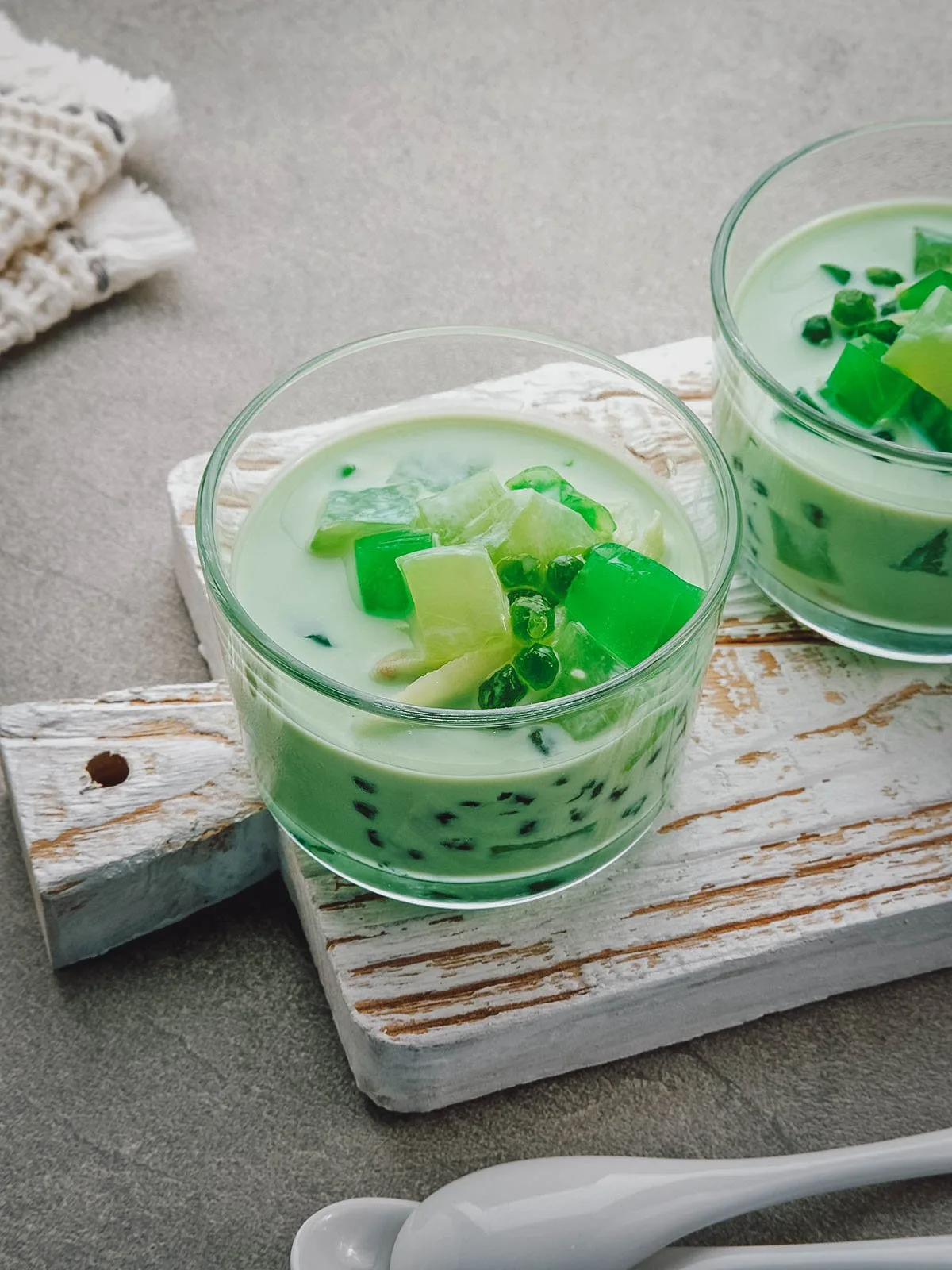
Photo by tyasindayanti
24. Fruit Salad
Fruit salad is one of the most popular Filipino desserts in the country. It’s a staple dessert at many households and often served at parties and family gatherings.
There are many delicious recipes for fruit salad but it’s typically made with fruit cocktail, sweetened condensed milk, and all-purpose cream. Depending on who’s making it, other ingredients are often mixed into this cold and refreshing dessert like kaong (sugar palm fruit), nata de coco (coconut gel), and sweet corn kernels. When it’s made with young coconut shreds, it becomes known as buko salad.
Filipino fruit salad can be eaten at room temperature, which is how I like it, but it’s mostly chilled or frozen before serving. Attend a Filipino party and you may find a bowl of fruit salad right next to a bowl of buko pandan.
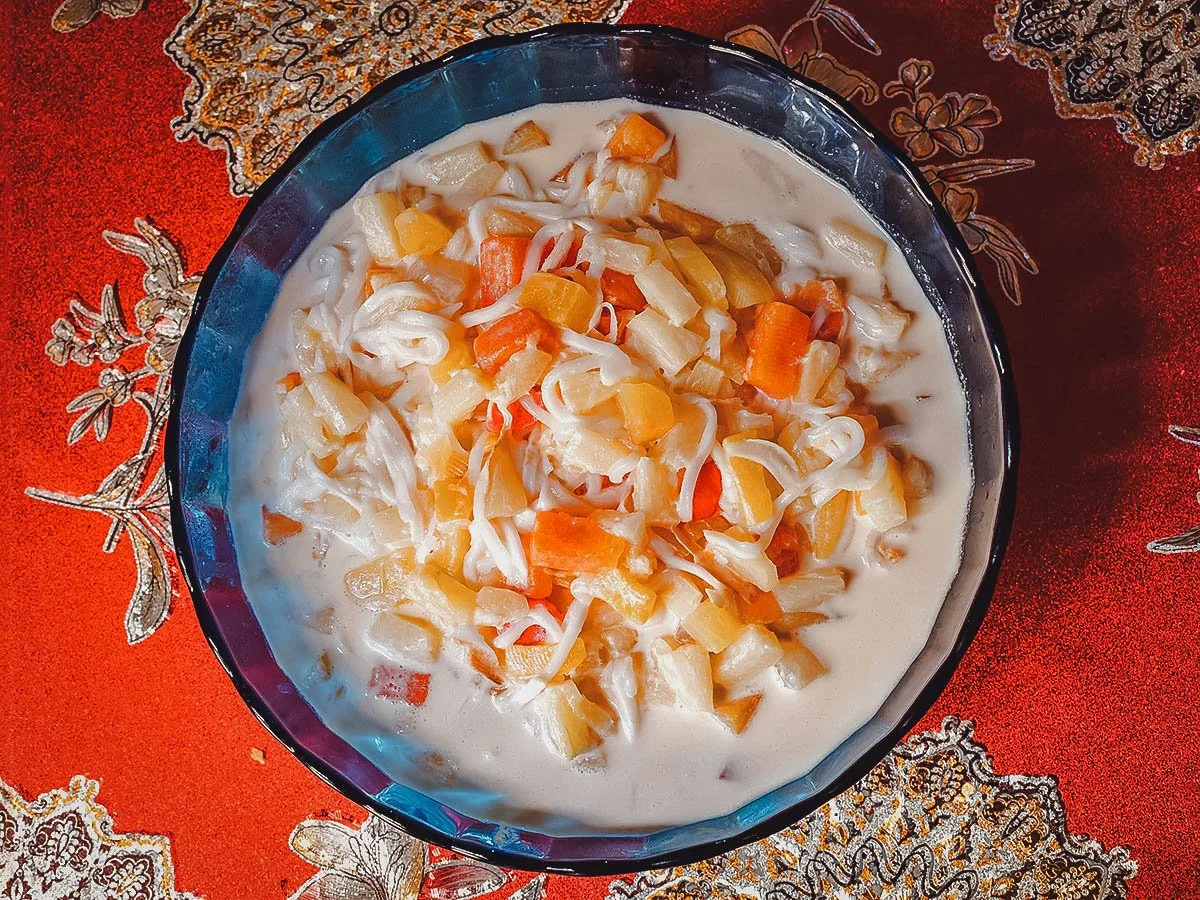
Photo by MikeEdwards
25. Ube Halaya
Unless you shun social media like the plague, then this last dessert needs little introduction. What you’re looking at is ube halaya or purple yam jam. Thanks to its rich purple color, it’s taken social media by storm in recent years and is used as the main ingredient in many desserts like ice cream, cakes, croissants, and cookies.
When I was growing up, we didn’t have any of those fancy desserts. To get our ube fix, we’d dig into jars of purple yam jam and eat it directly off a spoon. Nowadays, we have an endless variety of delicious Filipino desserts made with purple yam, but licking it off a spoon is still my favorite way of enjoying ube.
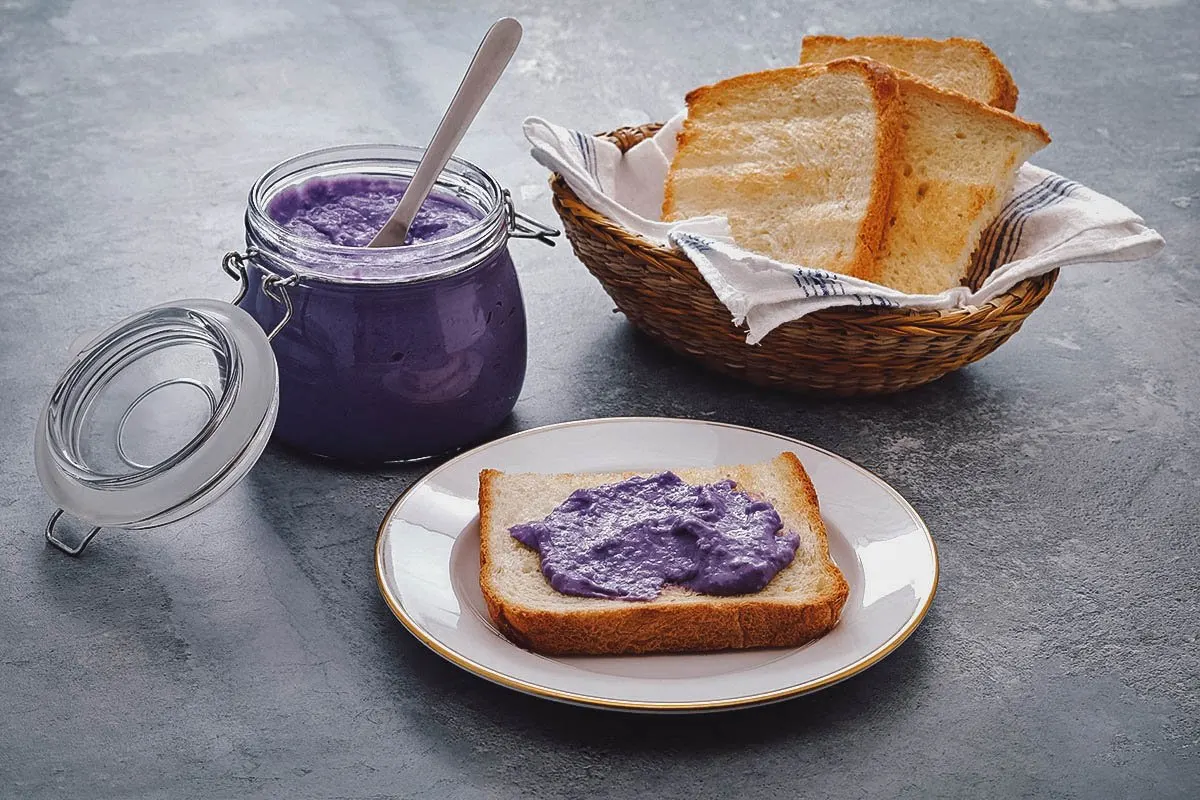
Photo by asimojet
FINAL THOUGHTS ON FILIPINO DESSERTS
Anyone who knows me well knows that I don’t have much of a sweet tooth. But there are a few Filipino desserts that I just cannot live without. Delicious sweet treats like leche flan, taho, ube, and kutsinta always bring me back and never fail to put a smile on my face.
To be honest, Filipino food can be polarizing. There are many weird Filipino dishes like balut or dinuguan. It isn’t one of the more universally appealing Asian cuisines like Thai or Japanese, but there’s less of a debate when it comes to Filipino desserts. Most are delicious so I suggest trying as many as you can on your next trip to the Philippines.
Cover photo by junpinzon. Stock images via Depositphotos.

